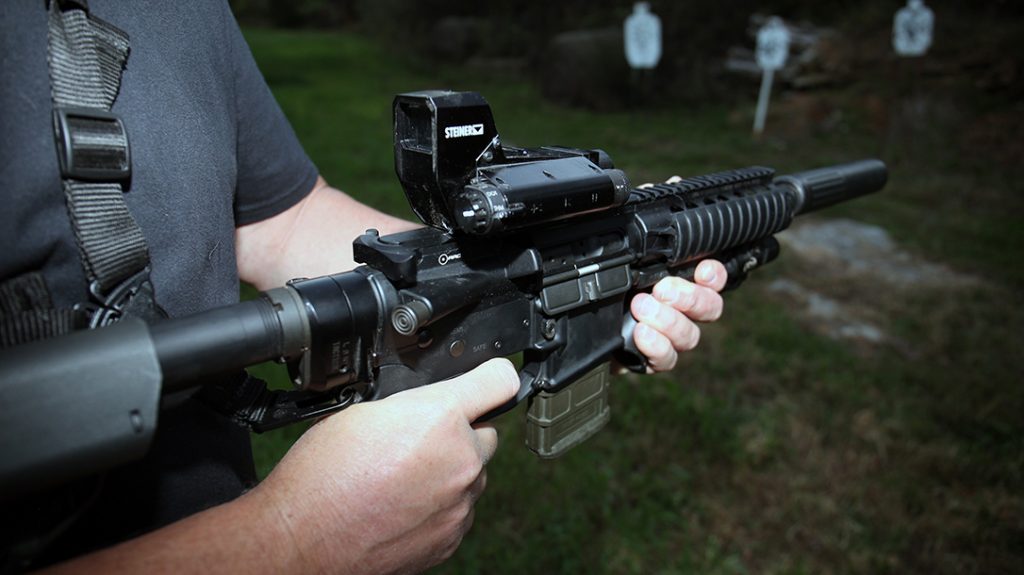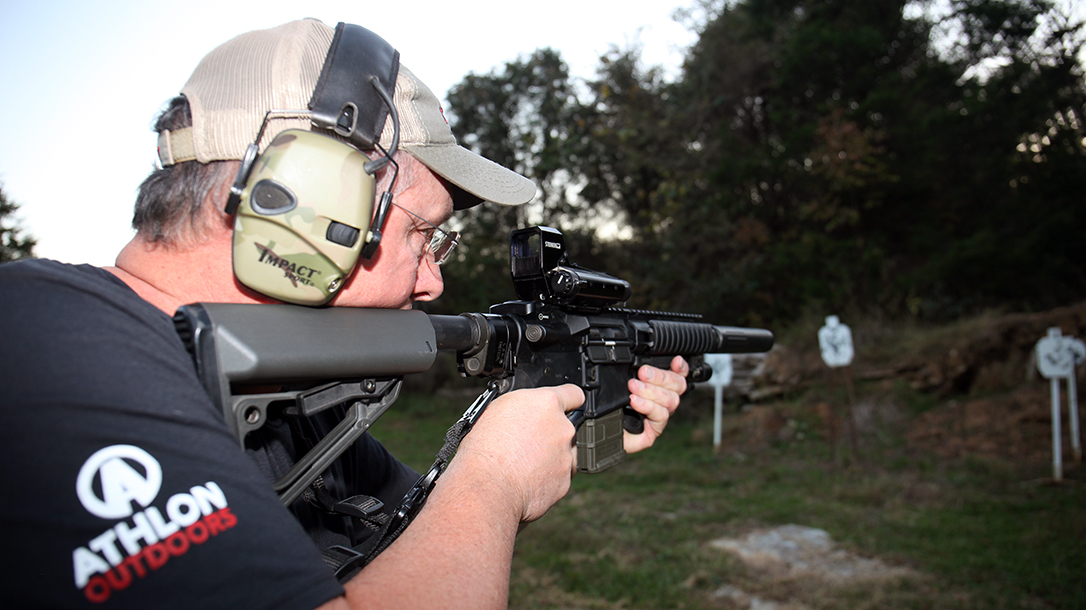Two years have passed since I first went “eyes on” with a top secret optic that Steiner still had in its prototype phase. In October 2018, during the annual Athlon Outdoors Rendezvous, we met with Steiner’s top man to get a peek at their cutting-edge Wraith thermal sight. What set this unit apart, now released to military and law enforcement as the Steiner CQT (Close Quarters Thermal Sight), was that the thermal image displayed as an outline rather than blotting out the target. The fact that the optic was rather compact for a thermal sight, and also that it could be used as a day-use red dot, made it that much more versatile.
Steiner CQT Details
I finally got the opportunity to actually mount a CQT on a rifle and put it to use recently. A few weeks ago a package arrived with a well-worn CQT inside.
The Steiner CQT is a 1X magnification combination red dot and fused thermal imaging device intended for rifle mounting. It combines the functionality of a precision 2.5 MOA red aiming dot with a heads-up display thermal imager. Afocal optics with a large eye box and long eye relief ensure the red dot is always on target regardless of eye position behind the sight. The same afocal optics and large viewing window overlay thermal imagery on top of the operator’s direct view of the target area.
Advertisement — Continue Reading Below
The operator can rapidly toggle between three thermal modes: Outline, full, and gradient. Outline is especially good at highlighting warm objects in the scene without obstructing the operator’s direct view of them. Full mode enhances warm objects in the scene, improving the operator’s ability to quickly detect targets hidden by camouflage, brush or the tree line, or obscured by smoke or fog, without cluttering the sight with thermal imagery of the terrain and background. Gradient mode enables target detection and engagement and situational awareness in low light and dark conditions. The thermal also turns off, making the CQT a high performance red dot sight with long battery life.
Tech Specs
Among the optical characteristics is an objective lens with 18mm focal length, and 1X optical magnification. It is factory focused with an effective range from 5 meters to infinity. The eye relief is 90mm at 12 degrees with thermal HFOV and a fixed diopter. The eyepiece size is 32mm x 23mm; this provides a field of view that is 12.2 degrees high and 9.7 degrees wide. The display provides a high brightness OLED microdisplay, with SVGA that’s 800×600. The unit weighs 20.58 ounces with two CR123A batteries installed, and it measures 5.32 inches long, as wide as it is tall at 3.07 inches.

Advertisement — Continue Reading Below
As previously mentioned, two CR123A batteries provide an operating time of eight hours in thermal mode, and about 1,000 hours with only the red dot illuminated. Operating temperature ranges from -40 to 158 F. It is shock rated to 1,000 Gs. Imaging frame rate is 60Hz, and the digital zoom give you a choice between 1x, 2x, 3x and 4x.
Tremendous Versatility
Here’s where the Steiner CQT gets really interesting–the thermal modes toggle between off, or course, outline, full and gradient. The digital reticle toggles between a crosshair, crosshair plus dot, crosshair plus circle, dot, box dot and none. It allows viewing only the thermal mode selected. The red dot comprises 2.5 MOA, and is zeroes separately. According to Steiner, detection ranges for a human is 400 meters, with recognition at 222 meters and precise identification at 145 meters. The red dot also regulates between day and night use by raising and lowering a daylight filter. My personal experience with the CQT’s ID range is that I could distinguish between bucks and does 150 away yards at night. This was during late summer when bucks still had warm blood pumping through the velvet covering their growing antlers.
Range time
To get some trigger time, I mounted the CQT on my favorite SBR, a Bravo Company AR lower/AAC upper in 300 BLK. This rig also wears an AAC SDN-6 suppressor, and Gen 1 Law Tactical stock folder.
Advertisement — Continue Reading Below
Sighting a dedicated thermal sight can be a pain. I’ve taped a Hot Hands hand warmer to a target, dialing the rifle in, countless times. Sighting in Steiner’s CQT is a snap by comparison. Sight in the red dot during daylight, then twist the knob to the thermal setting to find the thermal reticle. The thermal reticle adjusts to co-witness with the red dot. It’s that simple. I ran the optic for more than 100 rounds of 300 BLK. Then I mounted it on a lightweight Ruger Hawkeye Hunter in 6.5 PRC. The CQT held zero after 100 rounds of stiffer recoiling 6.5 PRC.
Steiner CQT units are available to military and LE for $9,999 now, and will be available to the civilian market in 2021. However, the civilian version will cost less, and will lack some of the ruggedness of the military spec optic. For more information, please visit Steiner-Optics.com.























